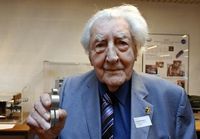Belgian artist Paul Van Hoeydonck, creator of the first artwork on the moon, died on Saturday afternoon, May 3, 2025, at the age of 99, according to a press release from his family. He passed away peacefully at home in Wijnegem, Antwerp, surrounded by his wife, Marleen.
Born in Antwerp on October 8, 1925, Van Hoeydonck was a versatile artist whose talents spanned sculpture, painting, drawing, collage, and graphic art. He studied at the Institute of Art History in his hometown and also at the Institute of Art History and Archaeology in Brussels. His artistic journey saw him experimenting with modern materials such as bronze, chrome steel, plexiglass, polyester, and mixed media.
Van Hoeydonck is best remembered for his iconic sculpture, "Fallen Astronaut," which was left on the moon by the Apollo 15 astronauts in 1971. The statue, which stands at just 8.5 centimeters tall, was intended as a tribute to the fourteen astronauts who had lost their lives up to that point, and it was placed alongside a plaque bearing their names. Until February 2024, it was the only artwork on the moon.
Philip Heylen, a friend of Van Hoeydonck and former deputy mayor of Antwerp, shared poignant reflections on the artist's passing, stating, "A few weeks ago, we were still with him to celebrate his 99th and half birthday. At that moment, it was clear that his light was slowly dimming. It feels surreal that Paul is no longer with us. You almost thought he would be there for eternity. And perhaps he will be, thanks to his enormous artistic legacy. Through his works, he continues to communicate with us."
Despite the monumental achievement of having his work on the moon, Van Hoeydonck faced challenges in his artistic career. He initially intended to sell replicas of "Fallen Astronaut," but was forced to abandon this plan due to NASA's prohibition on commercial exploitation of the U.S. space program.
Van Hoeydonck's fascination with the cosmos and the relationship between humanity and technology was evident in his body of work. In the 1960s, he created geometric-abstract pieces, often exploring themes related to the future and human existence. His American gallery owner suggested the idea of sending a piece to the moon, which ultimately became a reality.
The Apollo 15 mission crew, including astronaut David R. Scott, took the small figure to the moon. Scott left the statue behind, intending for it to stand upright, but this proved impossible due to the lunar surface's conditions. Instead, the sculpture now lies next to the memorial plaque.
Van Hoeydonck's work was not only recognized in Belgium; he exhibited internationally, with pieces held in prestigious collections including the Museum of Modern Art (MoMA) in New York. His artistic contributions extended beyond the moon, with exhibitions in cities such as Milan, Tokyo, and at the Guggenheim Museum in New York.
In February 2024, another piece of art, "Moon Phases" by American artist Jeff Koons, landed on the moon, introducing new elements to the lunar landscape. This piece consists of a cube with 125 steel balls representing the phases of the moon, each linked to notable figures from history.
As the art world mourns the loss of Van Hoeydonck, his legacy lives on. His contributions to the dialogue between art and space exploration have left an indelible mark. The "Fallen Astronaut" not only serves as a tribute to those who have sacrificed their lives in the pursuit of space exploration but also stands as a testament to the creativity and vision of Van Hoeydonck.
In his own words, Van Hoeydonck once expressed a sense of disappointment in not achieving the fame he had hoped for after the placement of his sculpture on the moon. "I thought I would become as famous as Picasso, but the opposite was true. I was laughed at," he remarked, reflecting on his experience in the art world.
Despite the challenges he faced, Van Hoeydonck remained active in his artistic pursuits well into his later years, continuing to explore new mediums and themes. His work has been celebrated in various exhibitions, including retrospectives in Antwerp in 2014 and 2021.
As the world reflects on the remarkable life of Paul Van Hoeydonck, it is clear that his contributions to art and humanity will not be forgotten. His journey from Antwerp to the moon is a story of creativity, ambition, and the enduring power of art to transcend boundaries.
Van Hoeydonck's passing marks the end of an era, but his legacy will continue to inspire future generations of artists and dreamers. The "Fallen Astronaut" remains a symbol of hope and remembrance, a reminder of the human spirit's quest for exploration and understanding.




